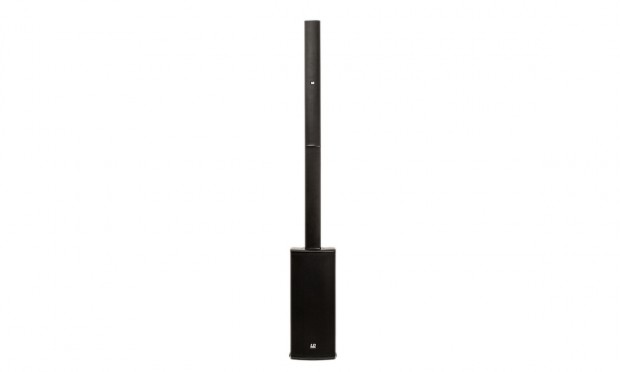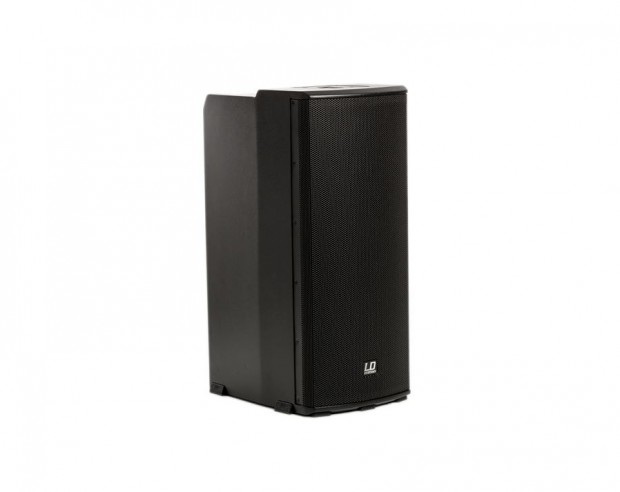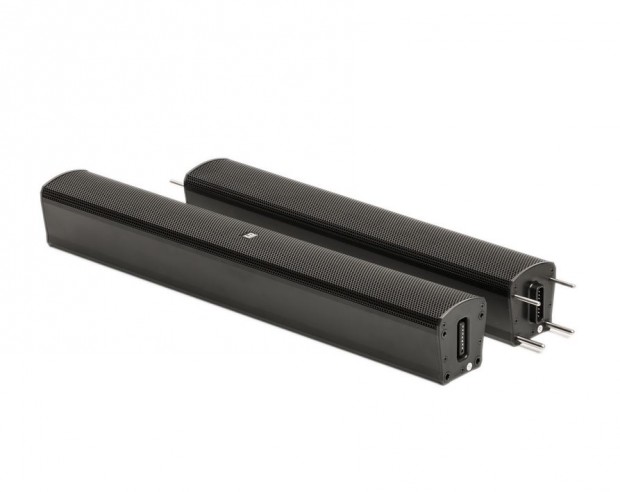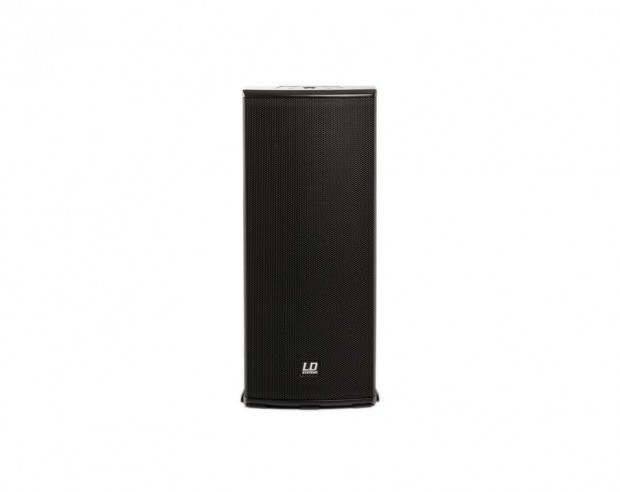LD Systems Maui 11 G2 – Test report from bonedo.de
LD Systems has treated its Maui series to a facelift and has also optimised its specification. In doing so, the new Maui 11 G2 not only looks more stylish, but also features more speakers. This should result in more volume and better sound, assisted by 500 watts RMS and the new DynX DSP. There is also a built-in four-channel mixer. Other new features include a Bluetooth interface and the option to run a stereo PA with a second Maui 11 G2. The individually controlled subwoofer has been retained as well as the price of just under 700 euros. We just had to test it.

Details
If the product name indicates the number of installed speakers, the new Maui G2 should actually be called 13, because the high-frequency range and the subwoofer each feature an additional speaker. As such, the subwoofer’s elegantly designed birch ply cabinet now houses three 6.5-inch speakers with 1.5-inch voice coils. And two 1-inch tweeters now work alongside the eight 3-inch mid-range loudspeakers in the column’s aluminium housing. The design appears slimmer, although the dimensions are almost identical. The subwoofer’s bass reflex housing measures 285 x 650 x 373 mm and weighs 17.8 kg. The two-part column comprises the empty spacer column, which measures 96 x 620 x 104 mm and weighs 2.5 kg, and the mid- and high-frequency range column loudspeaker, which measures 96 x 730 x 104 mm and weighs 5.5 kg. The entire system is 2030 mm high and weighs 25.8 kg in total. Like many Maui models, the 11 is available in both black and white (Maui 11 G2W).

Technology
The multi-lingual manual provides a concise yet adequate explanation of the system, as well as of the new DynX DSP: It takes care of the frequency distribution of the three bands, serves as a multiband limiter and protects against overload, short-circuit and thermal overload. One of the purposes of the multiband limiter is to smooth any peaks in the respective frequency, so that the system can be used at higher volumes without problems. The Class D amplifier delivers 500 watts RMS (2000 watts peak). According to the manufacturer, the system has a frequency response of 50-20,000 Hz and a continuous volume of 118 dB (124 dB peak) at a dispersion angle of 120 x 20 degrees.
The speaker’s master volume control is separate from the mixer, located on the subwoofer housing; the subwoofer level can be adjusted depending on the main level. The four main indicators include the power indicator, the signal flow LED, the limiter LED and the red warning indicator for the protection circuit. Alongside these are the set-up indicators: The system can be used as a line array, or the columns can be separated from the subwoofer and either wall-mounted (with optional accessories) or placed on stands. The DSP (24-bit, 48 kHz) reacts automatically and optimises the components accordingly.
Next to the set-up indicators are the LEDs and switches for mono or stereo operation. If the Maui 11 G2 is used in mono, any stereo signals are summed into mono. A second Maui 11 G2 would enable the signal path to be split via stereo switching, so that this system would provide only the left stereo channel. The Master-Out now controls the right channel of the stereo signal depending on the main level.
The four mixer channels are arranged as follows: one microphone input with combined XLR/jack socket, a line-in with two combined sockets and stereo RCA-pairs, a high impedance input with 6.3-mm jack socket and the Bluetooth channel with a mini jack for external music sources. The master signal can be sent to a male XLR socket as described above.

Optional Accessories
Standard equipment of the Maui 11 G2 comprises the speakers only, without additional accessories. Protective covers and transport bags are available separately from LD systems – a must for the travelling user, ensuring convenient storage and safe transport. There are also optional stands and wall brackets in matching colours to facilitate other installation or mounting options.
In use
Right from the start, my enthusiasm is dampened as I still have to struggle with the guide pins on the column sections. In this case there is only one way to assemble the column, as the spacer column must be installed between the subwoofer and speaker column, because of the guide pins on each side. With the Maui 11 G2, you now need an extra pair of hands to be able to do what you could do single-handedly with the Maui 28 G2. After assembling and dismantling the unit several times, the connectors should slide together more smoothly. However, a few drops of silicone oil may be useful here.
When assembled, the system makes a stylish and discreet stage companion. The look is very elegant and impressive, with soft lines and a slim profile. Only Bose achieves an even slimmer profile. With a footprint of around 0.11 square metres and a height of over two metres, you can place the sub directly on the floor and it will still project over the heads of the audience.

LD Systems Maui 11 G2 – Sound
A greater acoustic surface area produces more sound. The Maui 11 G2 features additional high- and low-frequency drivers. This should reduce the load on the eight mid-range speakers. At moderate levels, the frequency response appears consistent. Your enjoyment of the music is not impaired by any drop-out in the mid-range, and the sound remains crystal-clear and full, regardless of the genre being played. The high-frequency horns are installed right at the top and project over head-height, thus guaranteeing brilliant sound on the fullest of dancefloors, even at close range. The independent subwoofer level control is also excellent, enabling the bass level to be accurately tailored to suit the room and your taste.
The Bluetooth option of the MP3/Bluetooth channel switches itself on after pressing and holding the corresponding button for a few seconds, and can be connected to any source, whereby the stability of the radio link is second to none. Simultaneously connected wireless mice, various workstation keyboards and even an open WLAN do not impair the quality of transmission. Alternatively, (or in parallel) I can plug an analogue phone mini-jack into the same channel without any buzz or hum to disturb my enjoyment of the music.
The mono summation of the stereo channels deserves special mention: Stereo delays and wide-panned chorus effects are not lost, even though they are re-aligned to come out of the centre. Everything stays punchy and impressive.
At party volumes, the subwoofer shows what it can do. It is almost as punchy and impressive as a 15-inch model, just not quite as deep. Three 6.5-inch drivers do not quite get the trouser-legs flapping. To deliver decent bass, the Maui 11 G2 really needs a little boost in the 50 Hz range. This is not necessarily evident in small bistros or bars, as the system efficiently delivers the upper bass frequencies.
As it reaches maximum volume, the sound becomes really harsh in the high frequency range. The multiband limiter may be compressing just a little too much. I prefer to turn the volume down a little and enjoy a better sound. Even when throttled back like this, the system delivers considerable volume and you have to shout to have a conversation.
One drawback is the inherent background noise. There is a constant hiss, regardless of how the controls are set. It is even more surprising that at full throttle, the system does not make more noise. The manufacturer is aware of this problem, one of the major differences between the virtually silent Maui 28 G2 and the Maui 11 G2.
The horizontal dispersion angle of 120° is extremely apparent, with consistent sound reproduction even right next to the cabinet. As with more expensive column systems, additional monitoring may not be necessary under certain circumstances.

LD Systems Maui 11 G2 – Mixer
The mixer sums without effects and sound control and volume reserves of the line and MP3/Bluetooth channels adjust along with their sound at a high level. However, I have to turn the microphone channel up to 75 percent to achieve 0 dB. If the Maui is used with instruments, Bluetooth and line signals, I can barely keep up with the microphone unless I shout.
So I immediately test its feedback-resistance and I am pleasantly surprised. Even with playback, master and sub at 50 and the microphone at 75 percent, there is no sign of feedback. And now it is already really loud! And my SM58 sounds well-balanced and blends perfectly with the playback. Feedback only occurs if I hold the microphone directly in front of the tweeter. Even with all of the controls on maximum, the system is still usable, without any constant whistle to ruin the show.
Now I plug my bass into the Hi-Z input. The gain is very good and with the controls half way up, I achieve an effective volume level. The pickup is transferred well and the bass growls nicely. Even the most aggressive slapping poses no problems for the limiter. With a line or Bluetooth signal, it is reassuring to hear the compression on the peaks.
Less impressive: In spite of the Hi-Z input, the pickup hums and buzzes. Although it disappears for the most part when playing, the noise can be heard during quiet passages. In this regard, the Maui 28 G2 is much better! Alternatively, I plug the bass into the line input and it is completely unable to deal with the pickup. It does not buzz or hum, but the sound is very muffled and uninteresting.
The mixer is more than a stopgap solution for small concerts, despite the lack of volume displays or simple overload LEDs on the inputs and one-knob EQ on the microphone input. With a little discipline during soundcheck, you could even forego a small or medium-sized combo. For more tone-shaping and effects, an external mixer is essential, which can be connected in true stereo via the line channel.
User Groups
I have a 60th birthday for 50 people on a boat house coming up, for which I would love to use this system. Used in mono, it is suitable for up to 90 people, and in stereo for between 180 and 200. You have to accept the lack of really deep bass, but otherwise the Maui 11 G2 is ideal for solo entertainers, singer-songwriters, small bands and mobile DJs. The latter should however add a second Maui 11 G2 in order to run in “true stereo”.
This column system would also be suitable as a discreet on-stage monitor system, due to its feedback resistance and excellent sound quality. In an emergency, the system can be used as a back-up. If the main PA fails, simply turn the “monitors” towards the audience – if the hall is not too large. The sub’s easy handling also makes it perfect for lectures, poetry slams and presentations with interval music.
Conclusion (4 / 5)
The revised Maui 11 G2 provides good, clear sound at 500 watts RMS and a manageable four-channel mixer with Bluetooth interface. For purely vocal as well as musical performances, it can be used in mono to deliver quality sound for crowds of up to 90 people, and a stereo system will keep up to 180 dancers happy. It loses points due to the buzzing Hi-Z input and the inherent noise of the Class D amplifier. Before first assembly, a drop of silicone oil on the guide pins is recommended, to ensure that dismantling can also be managed alone. All in all, here we have an elegant and lightweight column PA that delivers consistent sound – and this for only 700 euros. Any small promoter, bar or bistro seeking an affordable all-round system will definitely find something in the Maui 11 G2. Four stars!
PROS
Great design
Feedback-resistant
Uncluttered four-channel mixer
Switchable stereo and mono
Separately controllable subwoofer
Interference-resistant Bluetooth interface
Suitable for use as PA or monitor
CONS
Inherent noise
Interference in the Hi-Z channel
Difficult multipin connectors

FEATURES
Compact, active line array with four-channel mixer
Available in black or white
Frequency response: 50–20,000 Hz
Maximum sound pressure: 118 dB SPL / 124 dB peak
Dispersion angle (H x V): 120° x 20°
Amplifier: 3-way Class D, 500 watts RMS, 2000 watts peak
Protective circuitry: multi-band limiter, thermal overload, short circuiting, DC voltage
DSP: 24-bit, 48 kHz, 100 dB signal to noise ratio (DynX DSP)
Switching power supply: IEC, 100-240 V AC, 50-60 Hz
Power consumption (off/on/max): 0 / 11 / 600 watts
MIXER
Channel 1: microphone / combo socket, gain control
Channel 2: line-in, 2 x combo jacks, stereo phono sockets, gain control
Channel 3: Hi-Z, 6.3 mm jack socket, gain control
Channel 4: Bluetooth, activation button, mini-jack for MP3, gain control
Outputs: line XLR, (mono summed / stereo right channel)
Master: main level, sub level (dependent upon on main level)
SUBWOOFER
Loudspeakers: 3 x 6.5-inch mid-range drivers, each with 1.5-inch voice coil
Housing: birch ply, textured paint, bass reflex
Dimensions (W x H x D): 285 x 650 x 373 mm
Weight: 17.8 kg
COLUMNS
Loudspeakers: 8 x 3-inch mid-range drivers, each with 1-inch voice coil
Housing: aluminium, HD-coated, sealed
Dimensions 1 (W x H x D) / Weight: 96 x 620 x 104 mm / 2.5 kg (spacer column)
Dimensions 2 (W x H x D) / Weight: 96 x 730 x 104 mm / 5.5 kg (speaker column)
PRICE: 699 euros MSRP












